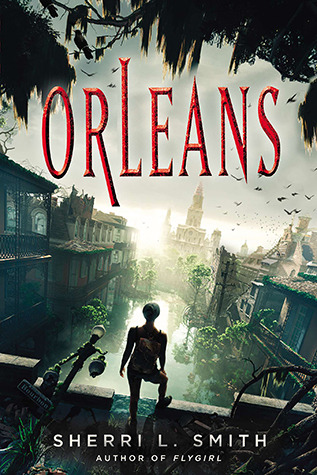Orleans by Sherri L. Smith
Young Adult Fiction
Reviewed by Kimberly Christensen

Reading novels about the environment requires a certain amount of getting comfortable with potential dystopian futures. For example, it would be extremely difficult to avert a climate crisis without thinking through the logical outcomes of the current course of (in)action. But it can be difficult for an author to hit the right notes between doomsday and engaging thought experiment. Happily, Orleans manages to straddle that line for a thoroughly engaging read grounded in a plausible premise.
After being pummeled by multiple category five hurricanes, flooded New Orleans becomes a breeding ground for a novel virus for which there is no cure. Initially, the United States government sends aid to Southern Louisiana, and families from other parts of the country even “sponsor children” in the affected areas. Eventually, a wall is built to contain the pathogen—and the people who host it—and New Orleans is largely left for dead.
But you can’t kill New Orleans.
Instead, society reorganizes itself. People realign along blood types. Type O is invulnerable to the disease, while type AB is the worst affected. Since “clean” blood can help keep diseased people alive, healthy people are captured for their blood, “blood farms” arise, and people are sold into blood servitude. Alongside this, religious orders tend the dead and dying. Scavengers make their living reclaiming objects from sunken structures. And while blood tribes rule in many areas, pockets of normalcy can be found in riverside communities where restaurants and markets exist in recognizable forms.
Fen de la Guerre—Type O—was born to two outsiders who arrived in New Orleans hoping to help its citizens avert disaster. After Southern Louisiana was abandoned by the United States and the situation at their university became unstable, they fled with their young daughter. Eventually, the blood tribes came for them. Young Fen escaped alone. Six years later, the Type O tribe she joined as a child is decimated by a blood war. Fen flees with her newly dead friend’s newborn baby and a promise to care for the child. Soon, she and the baby are caught by blood farmers.
Daniel is a doctor from the Outer States who has spent his life working on a cure for the disease. He sneaks into Orleans in hopes of meeting local researchers who will help him refine his treatment. Instead, he’s captured by the same blood farmers who captured Fen. Together, they escape, thus beginning a quest to get Daniel in touch with people who might help him, and the baby to safety.
Orleans is a riveting read. The world building is engrossing, with Southern Gothic and horror elements intertwined with a climate-ravaged New Orleans. Smith holds a mirror to the failure of institutions—governments, religions, academia—to actually serve the people and shows the resilience of the people themselves, even when sometimes that resilience isn’t pretty. Fen is the embodiment of that resilience, making the hard choices and honoring her debts. While her character evokes some emotional resonance, she does keep the reader at arm’s length when it comes to her feelings. However, her story and arc hold together and with the strong world-building, make Orleans and excellent read.
Five of five stars.